Once upon a time, a long-forgotten Danish Astronomer Tycho Brahe established a theoretical model of the universe known to us as Tychonic Model or Tycho Brahe Model of the Universe.
The Tychonic model basically unified the mathematical benefits of the Copernican System or Sun-Centere Universe with the philosophical benefits of the Aristotelian Universe or Earth-centered Universe.
What is the Tychonic Model?
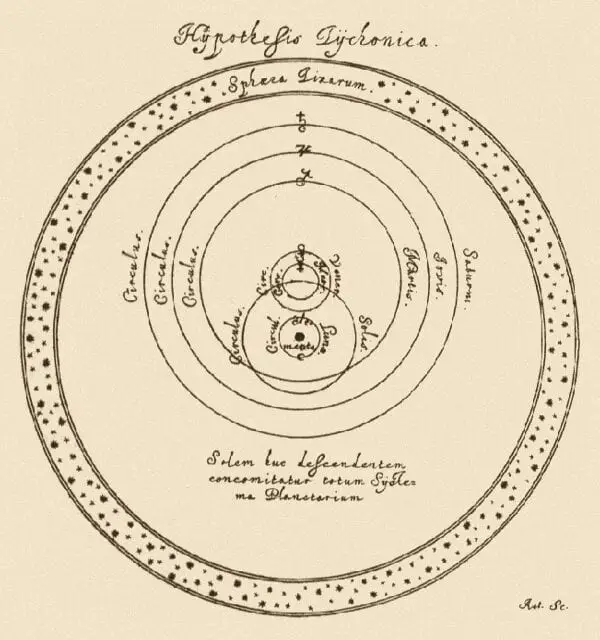
The Tychonic model is a theoretical model of universe that hypothesizes that earth is center of universe. The sun, moon, & stars revolve around the earth. And all other planets within our solar system revolve around the sun.
That’s why this model is also referred to as the geo-heliocentric model of the universe. Simply because it inherits the combination of both.
In other words, Tycho’s model retains the ancient Aristotelian view that (stationary) earth is the center of the universe, where the sun and the moon revolve around the earth.
On the other hand, retains the modern concept of the Copernican view that all the other planets within our solar system revolve around the Sun.
This theoretical model of the universe was proposed by Danish Astronomer Tycho Brahe around the 1570s.
Advocates and Admirers of the Tychonic Model
Well, if I go down the history of the Astronomical Timeline, in 4th Century BC, it was a Greek Philosopher and Astronomer Heraclides Ponticus who first proposed a similar model to the Tychonic model of the universe.
He proposed that at least Mercury and Venus revolve around the Sun.
Later after Heraclides, in the 4th century AD, a roman astronomer Macrobius Theodosius also proposed a similar model to the Tychonic System.
Moreover, according to the written scriptures, the Tychonic universe was in fact inspired by the two german Astronomers – Valentin Naboth and Paul Wittich.
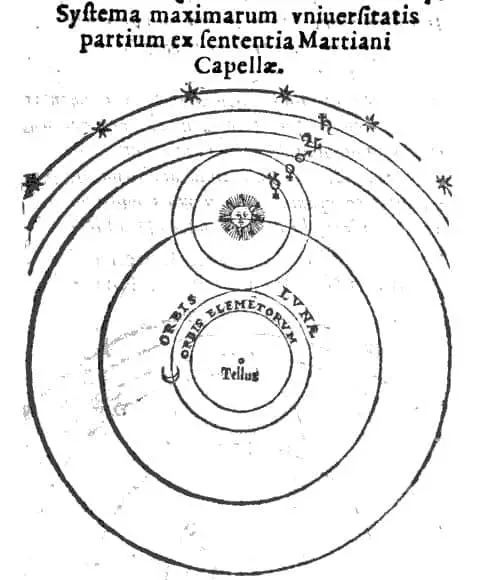
According to the Capellan Geo-helio-centric model, at least the inner planets (Mercury and Venus) revolve around the Sun. On the other hand, the outer planets (Mars, Jupiter, and Saturn) orbit around the Earth.
Almost a century before the Tychonic model, an Indian Mathematician, Astronomer Nilakantha Somayaji of the Kerala School Of Astronomy And Mathematics proposed the geo-heliocentric model of the solar system.
In his model of the universe, all the planets revolve around the Sun except the Earth.
Historical View And Development Of Tycho’s Model
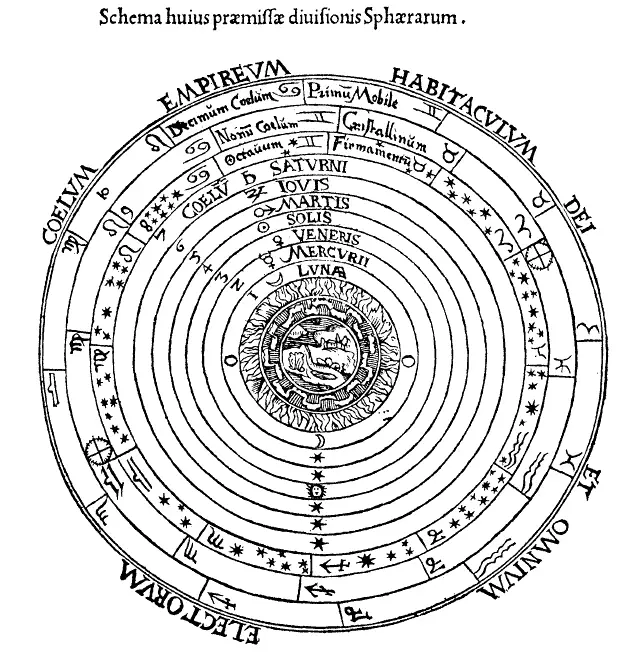
Well, in some sense; Nicolaus Copernicus, Brahe, and Kepler were contemporary to each other.
Brahe was a philosophical man. That’s why he retained the philosophical view of Aristotle’s beliefs. This means that earth was fixed at the center i.e Earth is immobile (motionless) and the sun and moon revolve around the earth.
On the other hand, Tycho Brahe admired the work of Nicolas Copernicus. So in order to make his system (Tychonic System) mathematically correct.
He retained the view from the Copernicus Heliocentrism that the rest of the planets revolve around the sun.
Hence, making his model of the universe a geo-heliocentric Model of the universe.
Although, he admired the work of Nicolas Copernicus. Yet he had some ideological differences regarding physics and astronomical observations of stars; as Brahe wrote,
This innovation expertly and completely circumvents all that is superfluous or discordant in the system of Ptolemy. On no point does it offend the principle of mathematics. Yet it ascribes to the Earth, that hulking, lazy body, unfit for motion. A motion as quick as that of the aethereal torches, and a triple motion at that.
Source: Owen Gingerich, The eye of heaven: Ptolemy, Copernicus, Kepler, New York: American Institute of Physics, 1993, 181
Brahe View On Copernican Model
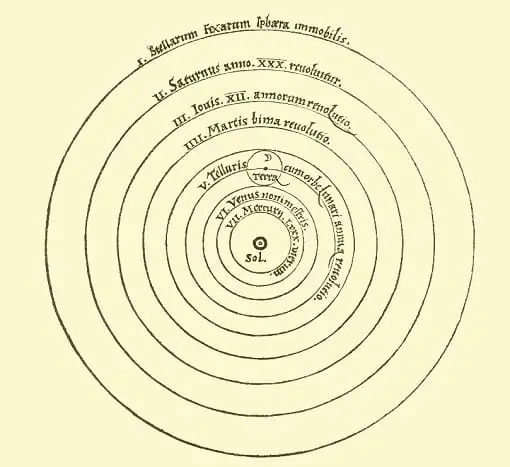
Tycho was disturbed by the facts regarding the physics (physical motion) given by Nicolas Copernicus. Therefore, he held the notion that the earth is too heavy and inactive to be continuously moving.
As per the prevailing Aristolean Principle of that time; the heavens and stars were made up of Aether or in the modern-day word “Quintessence”.
Aether is a substance so light on one hand and so strong on others. Therefore, responsible for the natural circular motion of stars and heaven. A substance not found on earth makes the earth immobile or lazy to be moved.
Take a look at the Top 6 Obsolete cosmological Theories Of The Universe
Regarding astronomical observations of stars given by Copernicus, Tycho Brahe theorized that if planet earth orbited around the sun (as in the heliocentric model).
Then there had to be an observable Stellar Parallax. Stellar parallax means the apparent shift of the position of an object, against the background of a distant object over a period of six months.
Meaning, there should be a change in the angular orientation of the star because of the motion of the earth.
Later, Johannes Kepler (his assistant) used Tycho Brahe’s observations and fused them with the Copernican Model. In return, derived Kepler’s Law Of Planetary Motion.
Rise And Demise Of the Tychonic Model
After the theoretical explanation given by Tycho Brahe for his Tychonic system; it became the major competitor with the existing Copernican Heliocentrism.
Because the Tychonic universe unified the Aristotelian universe with Copernican heliocentrism, hence, providing a conceptual bridge between Geo-Centrism and Helio-Centrism.
In the view of Tycho Brahe; the Tychonic system neither violated the laws of physics (Mathematical View) nor the sacred scriptures (Philosophical View).
The Tychonic System was more influential than the Copernican System in the late 16th and 17th centuries. Solely due to being philosophically more intuitive than the Copernican System.
In fact, this cosmological model remained at the center of astronomy until the discovery of the Stellar Parallax in 1838 by German Astronomer and Physicist Friedrich Bessel.
The observation of stellar parallax proved the fact that the earth did revolve around the sun.
Hence, became the only reason for the downfall or demise of Tycho Brahe’s model of the universe from the heart of the Astronomical world.
That’s it for this post. If you like this article, share it if you like it, like it if you share it. You can also find us on Mix, Twitter, Pinterest, and Facebook.
You might also like:
- Geocentrism vs Heliocentrism in Tabular Form
- 6 Newton’s First Law of Motion Examples in our Daily Life
- Newton’s 2nd Law of Motion Examples – Top 6
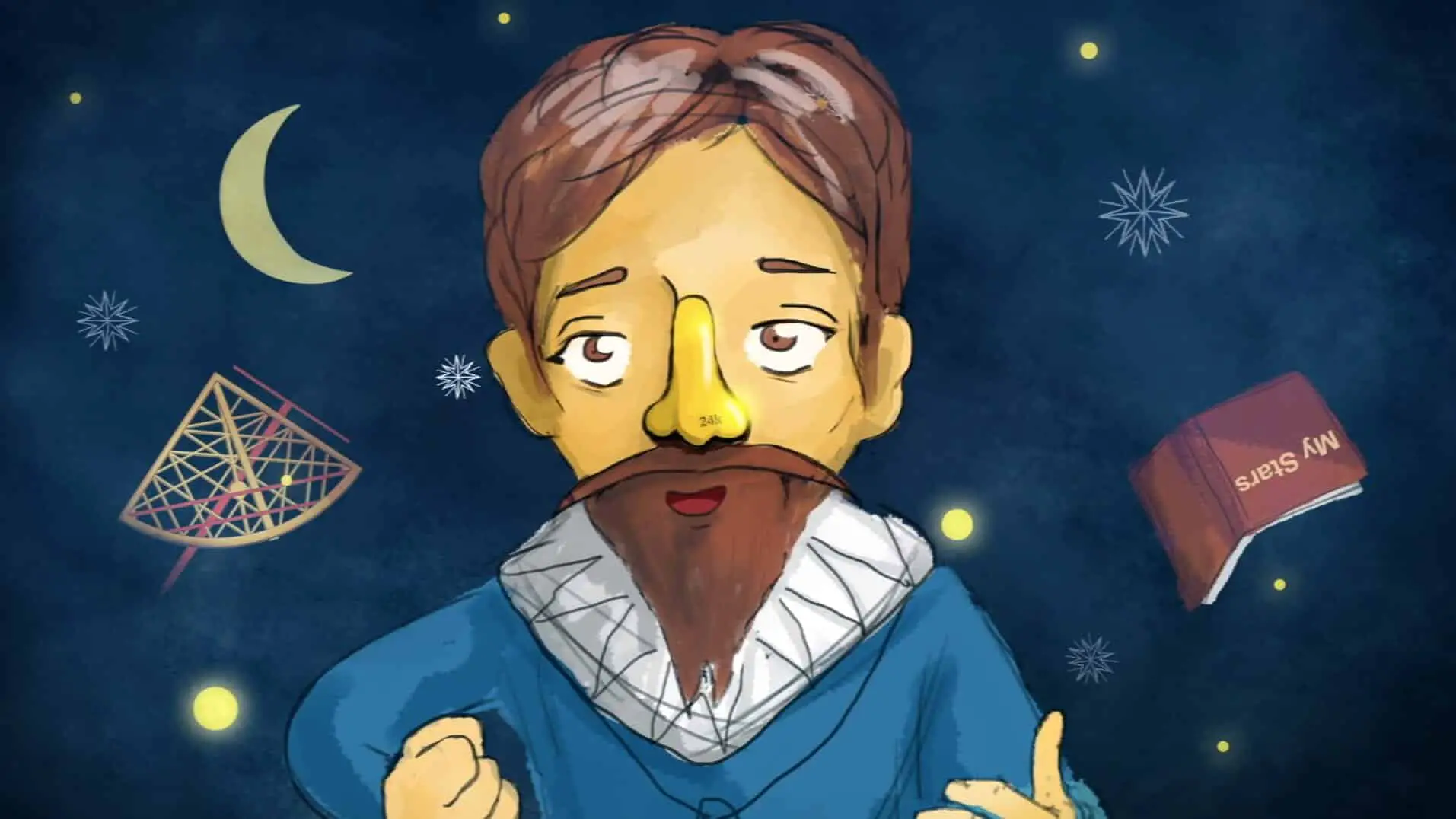
You say " The Tychonic System was more influential than the Copernican System in the late 16th and 17th century due to being philosophically more intuitive than the Copernican System. Brahe's Cosmological System remained the center of the astronomy until the discovery of Stellar Parallax in 1838 by a German Astronomer and Physicist Friedrich Bessel." The second sentence implies that the Tychonic system dominated up until 1838, which is nonsense. Most of European astronomy was decidedly Copernican from 1700 onwards, and certainly just about 100% by 1775 onwards.
What is Tycho Brahe world ig view Geocentric, heliocentric or Geo-heliocentric?
Hey Shine,
I would say that the Brahe system or simply the Tychonic system is absolutely based on the geo-heliocentric view of the universe.
I enjoyed it. Heraclides of Pontus proposed a rotating centralized Earth which revolved around the UNSEEN GREAT FIRE. His only mistake was the Planet Venus. Check out my postings on viXra.org and on General Science Journal. Blessings
What about the negative stellar parallax discoveries?
Hello Atul, Heraclides revised the Pythagorean model of Philolaus who proposed an unseen GREAT FIRE at the center of the Cosmos. The model of Heraclides proposed a daily rotation and an annual revolution. Macrobius proposed a daily rotation. Nilakantha proposed a daily rotation.
Paul Wittich proposed a daily rotation. Martianus Capella, Aryabhata, Nicolaus Reimers, and Christian Sorenson proposed a daily rotation. Medieval Islamic Astronomy at Marangha and Istanbul proposed a daily rotation.
The Jewish astronomers in Madrid and Lisbon proposed a daily rotation. The Pythagorean feature of Heraclides solved the puzzle of the retrograde planets.
Hello Atul, Does your interest in Cosmology include the annual sidereal timekeeping of the constellations? If Copernicus placed the Sun at the center of the Cosmos as did the Pythagorean astronomer, Aristarchus; then the Earth is proximal and shares the center of the Cosmos with the Sun. The Sidereal Timekeeping model continues. Who moved the Sun from the center of the Cosmos and how did that affect the Sidereal Timekeeping model?
Hello again! It was St. Thomas Aquinas who replaced the rotating geocentric Earth of Macrobius and Capella since 500 A.D. with the Aristotle / Ptolemy model in 1250 A.D. It was the model of Heraclides from the translation of Timaeus by Plato by the scholar Calcidius. The Pythagorean solution to the retrograde planets was missing.
Greetings Atul, ln 1962, Kartrik Chandra Paul of lndia saw the planet Venus in conjunction with Polaris, the North Star. He knew what that meant: the textbooks are WRONG ! ! ! Two movies of his life exist. Should he believe his eyes or the textbooks? He lives in Kolkata, lndia. If you decide to become the Man of Destiny and begin your pilgrimage, then your first task is to pay homage to K. C. Paul. Blessings.
Thank you for pertaining to sharing that excellent written content on your website.
You are welcome, keep visiting us!!!